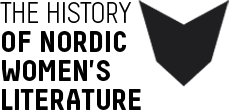The Inter-War Period
Ikke kategoriseret
In the work of writers in 1930s Denmark connected to the arts journal Linien – such as Hulda Lütken and Bodil Bech – the power and expressivity, the new, demanding ego that was given voice in Södergran’s writing, first made its mark. In their writings, inspiration from Södergran is seen as an intense provocation of the traditional late-Romantic verse language and poetic fixtures.It is tempting to say that the Södergran influence takes their writing to the verge of breakdown, whereas the third woman poet of the 1930s, Tove Meyer, lives and writes for long enough to accomplish the difficult manoeuvre out of late-Romanticism and into a new modernist style.
In 1944, fifteen years after Arnold Norlind’s death, his wife, the author and historian of religion Emilia Fogelklou wrote a biography of him. She was 66 years old. The book Arnold became the first volume of Emilia Fogelklou’s autobiographical trilogy, the high point of her prolific output.The books may seem out of order at first. Why does she not tell her story chronologically or in flashbacks? Arnold answers that question. Meeting Norlind was both the culmination and the beginning of her life. The book is one of the great love stories in Swedish literature, and a singular coming-of-age narrative.
Ragnhild Jølsen’s life and writing is marked by the tension between her rural home village and the bohemian milieu in the capital city, between robust popular traditions and aesthetic sophistication. From her very first publication in 1903, she was welcomed as remarkably mature, unusually gifted, and singular. But her “brutal, raw power” and “blatant, intensely erotic scenes” led many to believe that the author must be a man.Her books are concerned with a type of woman who is beautiful, vulnerable, and sensual, and whose mind vacillates between dream and reality. She broke sexual taboos and courageously showed that she saw body and mind as a whole package. Her literary output is a long way from the bourgeois, earnest, and everyday approach that characterised Norwegian literature in the early decades of the twentieth century. The sensitive, perceptive and the fantastical, exaggerated were key elements in her books and continued to be so.
The writing of Regine Normann (1867-1939) lent a new dimension to the Norwegian region of Nordland. She fused folklore with authentic depictions of everyday life. Her innovative idiom normalises the Nordland dialect in a way that permits the rhythmic narrative style to bring out the region’s mystical and popular mentality.Her many collections of legends, a number of which she had already used in her novels, place her as a folklorist who passed down the oral tradition. Many of Normann’s books revolve around conflicts and power struggles between different generations of women. The autocratic, vindictive, and pietistic mother figure reappears in various guises.The female characters in her Nordland tales have been spared a conventional, middle-class upbringing. Getting pregnant by your fiancé is no sin. In the Nordland of yore that Normann depicts, the natural, unbridled urges of the flesh can find satisfaction. However, Normann’s later works exhibit a pronounced religious tone.
Author and journalist Elin Wägner was a central character in the struggle for women’s suffrage in Sweden, and she was committed to pacifism. She wrote around twenty novels, a handful of short story collections, and many radio plays, wherein she over and over again argued that women had to emancipate themselves so that they could “find a form of their own.”
Women have always dominated the world of Finnish theatre as playwrights, producers, and directors alike. The long list of playwrights, includes Minna Canth, Elviira Willman-Eloranta, Maria Jotuni, Hagar Olsson, and Hella Wuolijoki.Finnish theatre is a young phenomenon and from the beginning it was heavily influenced by radical thought, nationalism, the labour movement, and Ibsenian realism. But the predominance of women stems from Finnish cultural history: their antecedents in popular poetry. Popular poetry offered strong female characters and positive role models. Playwrights drew on this inspiration to exalt young women who radiate sexuality, mature and responsible wives, and wise old matriarchs.
The deaf seamstress Maria Sandel, was a feminist, an active Social Democrat, and a favourite among Ellen Key’s circle. She has been referred to as the Fredrika Bremer of the proletariat. She was “among the strangest people who have ever held a pen in their hand”. For twenty-five years, she occupied a little room with a tiled stove in supportive housing. This place served as a rich source of material.She was a Swedish pioneer when it came to writing about overcrowding, the struggle to put bread on the table, the need for women to work two or three times as hard as men. But her goal was much more ambitious than mere social realism. She cloaked her ethical commitment in literary garb. Feminism was part of her project; she wanted to “correct men’s perception of women”. Like many others, she drew inspiration from Charles Dickens’s novels. And as was the case with other contemporary proletarian authors, her thinking was shaped by the labour movement’s goal of “raising up the working class.”
In 1909, the battle for women’s suffrage is raging. From London Elin Wägner covered “the greatest movement the world has ever seen”, the Fourth Congress of the International Women’s Suffrage Alliance. She was the most indefatigable opponent of the Swedish patriarchy for four decades.Her first memorable work was Pennskaftet (1910; Eng. tr. Penwoman), a novel that became a bible for “the new woman”. But Wägner is not alone. Selma Lagerlöf and Ellen Key are among the many Swedish women writers who join the struggle for women’s suffrage, and their authorships undergo a transformation in the heat of battle.
People’s attitude towards life is the essential thing in Minda Ramm’s oeuvre. Empathy, art, and philosophical wisdom can teach them how to put up with the contradictions that they encounter day by day. Thus, Ramm’s literary credo was the necessity of study and observation.

